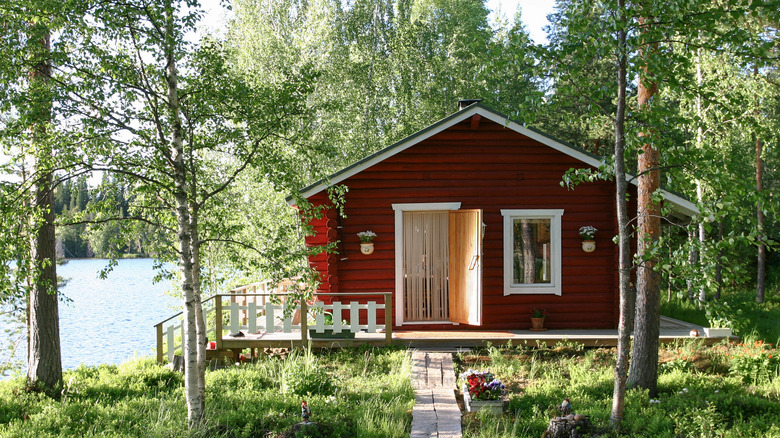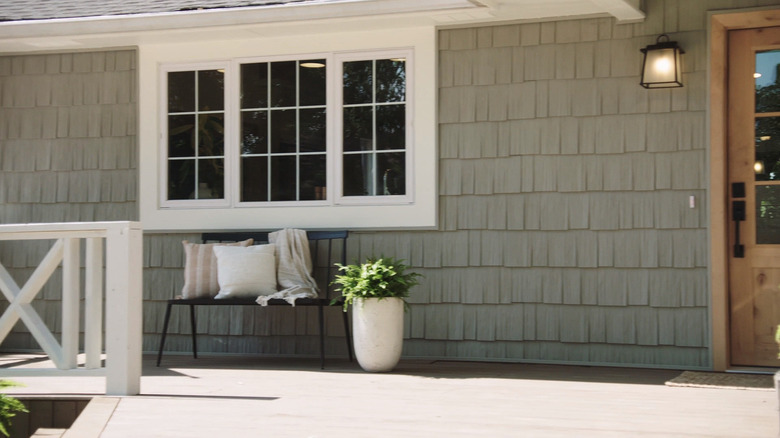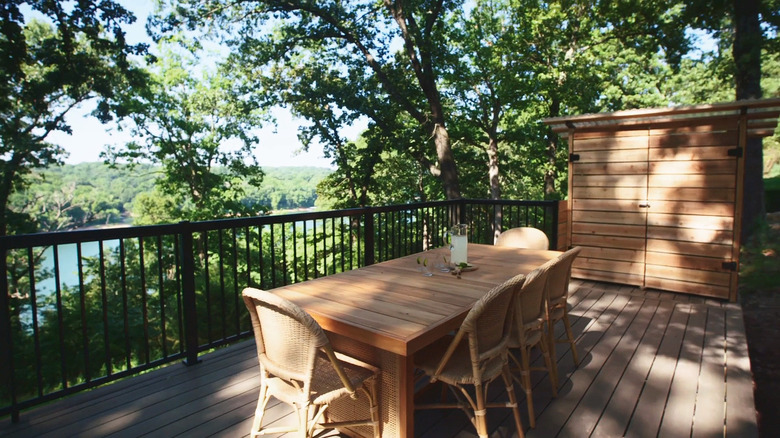Fixer To Fabulous Swears By These Two Indestructible Exterior Home Features
Reducing the amount of maintenance a home requires is a priority for just about every homeowner. So, when Jenny and Dave Marrs renovated a lake house for Whitney, a grandmother living on her own, they made a special effort to ward off as many future repair jobs as possible. The "Fixer to Fabulous" duo took the initiative to armor the home with composite shake siding and decking. "The key is for us to really set Whitney up so that she can just enjoy this place and not be managing the upkeep all the time," Dave Marrs said in the episode (via Realtor.com).
With a lake house, you can see the need for repairs coming across the water. Maintenance costs for lakeside houses can be higher than normal due in large part to the local humidity created by the body of water, which can contribute to accelerated rot, potential for flooding, and exposure to the elements. Siding on the home is likely to need replacement or repair far sooner than a home without the additional wear and tear.
Similarly, in some situations, wood decking can need replacement in 10 years. In both cases, the key factor in extending each product's life is regular maintenance. And, make no mistake, the potential for damage doesn't lurk only in the lake. Anywhere you experience any amount of rain, high humidity, or close proximity to the ground, both wood shakes and decking will need regular maintenance. The composite options, on the other hand, can last up to 50 years.
On a lake (or anywhere else), you want composite shake
Team Marrs initially considered painting Whitney's existing siding, and they might have briefly planned to replace it with cedar. (Jenny Marrs' blog mentions both cedar and composite shakes, though the episode only shows the result with composite) "We really want Whitney's house to be something that, when we're done, she doesn't have to mess with it," Dave Marrs said in the "Fixer to Fabulous" episode. They decided composite shake siding would require the owner to mess with it as little as possible while meeting her design goals. Rotted wood siding is a common surprise repair that can only be avoided with maintenance.
For homeowners looking to minimize maintenance, there are other weather-resistant options that, like composite siding, won't rot. These include vinyl siding, James Hardie fiber cement siding, and aluminum siding. In terms of visual appeal, there are vinyl siding options that have the texture and depth of rough-sawn cedar shakes, providing the "cottage look" Jenny Marrs was after.
The downsides are that vinyl has a tendency to fade in direct sunlight, isn't as durable in hot climates, and can become increasingly brittle with age. Hardie board does require painting every 10 to 20 years. And, aluminum siding fades relatively quickly, dents easily, and isn't available in convincing faux textures while composite and vinyl are. Composite siding costs about the same as vinyl. On the whole, a homeowner looking for unparalleled durability and the appearance of real wood can't do better than composite shake siding.
Decking options for homeowners
There are fewer generally better, low-maintenance decking options for homeowners. The Marrses opted for composite decking for the same reasons as the composite siding — durability and low maintenance — but acknowledged that it can be pricey. "We're using composite decking," Dave Marrs said, "which costs about three times more than wood. But, she's not going to have to worry about it at all."
The upsides of composite decking over wood are huge for homeowners: no sanding, staining, or treating; no rot; and no termites. Deck framing is constructed with treated lumber because it's durable and far cheaper than composite. But, in terms of the decking boards themselves, the ones you walk directly on, composite lasts about twice as long and doesn't require staining or treating regularly like wood does. Not staining your wood deck every two to three years is a common mistake. Dealing with all of that maintenance certainly offsets any savings you might get from going with wood over composite decking.
There is another, more recent option: PVC decking. It's more expensive than composite but harder and less prone to mechanical damage. However, when there is damage, composite can fare better because it usually has a uniform color throughout, while PVC tends to have a colored wear layer. PVC can last a lifetime, while composite decking will typically last 20 years or more. That said, it might not be an ideal option for any homeowner who's at all cost-sensitive. As with the siding, composite decking remains an ideal choice for homeowners.


